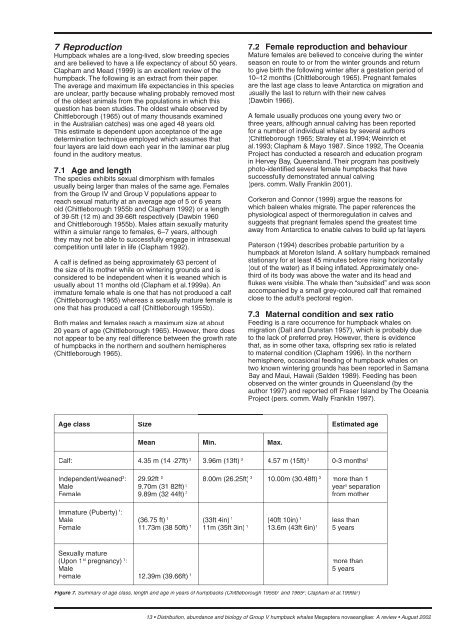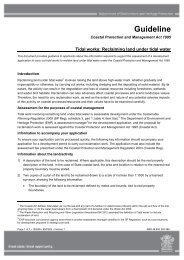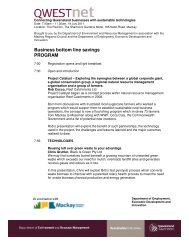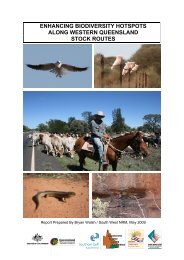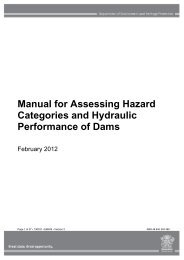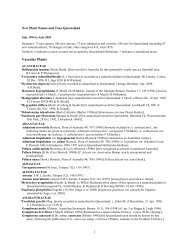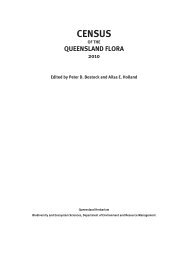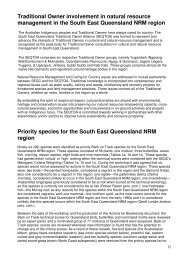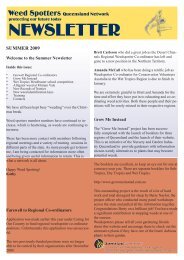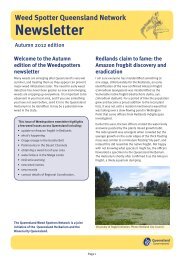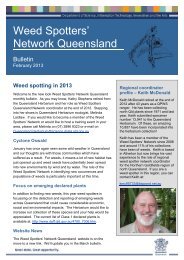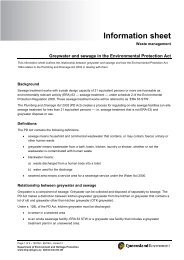Distribution, abundance and biology of Group V humpback whales ...
Distribution, abundance and biology of Group V humpback whales ...
Distribution, abundance and biology of Group V humpback whales ...
You also want an ePaper? Increase the reach of your titles
YUMPU automatically turns print PDFs into web optimized ePapers that Google loves.
7 Reproduction<br />
Humpback <strong>whales</strong> are a long-lived, slow breeding species<br />
<strong>and</strong> are believed to have a life expectancy <strong>of</strong> about 50 years.<br />
Clapham <strong>and</strong> Mead (1999) is an excellent review <strong>of</strong> the<br />
<strong>humpback</strong>. The following is an extract from their paper.<br />
The average <strong>and</strong> maximum life expectancies in this species<br />
are unclear, partly because whaling probably removed most<br />
<strong>of</strong> the oldest animals from the populations in which this<br />
question has been studies. The oldest whale observed by<br />
Chittleborough (1965) out <strong>of</strong> many thous<strong>and</strong>s examined<br />
in the Australian catches) was one aged 48 years old.<br />
This estimate is dependent upon acceptance <strong>of</strong> the age<br />
determination technique employed which assumes that<br />
four layers are laid down each year in the laminar ear plug<br />
found in the auditory meatus.<br />
7.1 Age <strong>and</strong> length<br />
The species exhibits sexual dimorphism with females<br />
usually being larger than males <strong>of</strong> the same age. Females<br />
from the <strong>Group</strong> IV <strong>and</strong> <strong>Group</strong> V populations appear to<br />
reach sexual maturity at an average age <strong>of</strong> 5 or 6 years<br />
old (Chittleborough 1955b <strong>and</strong> Clapham 1992) or a length<br />
<strong>of</strong> 39·5ft (12 m) <strong>and</strong> 39·66ft respectively (Dawbin 1960<br />
<strong>and</strong> Chittleborough 1955b). Males attain sexually maturity<br />
within a simular range to females, 6–7 years, although<br />
they may not be able to successfully engage in intrasexual<br />
competition until later in life (Clapham 1992).<br />
A calf is defi ned as being approximately 63 percent <strong>of</strong><br />
the size <strong>of</strong> its mother while on wintering grounds <strong>and</strong> is<br />
considered to be independent when it is weaned which is<br />
usually about 11 months old (Clapham et al.1999a). An<br />
immature female whale is one that has not produced a calf<br />
(Chittleborough 1965) whereas a sexually mature female is<br />
one that has produced a calf (Chittleborough 1955b).<br />
Both males <strong>and</strong> females reach a maximum size at about<br />
20 years <strong>of</strong> age (Chittleborough 1965). However, there does<br />
not appear to be any real difference between the growth rate<br />
<strong>of</strong> <strong>humpback</strong>s in the northern <strong>and</strong> southern hemispheres<br />
(Chittleborough 1965).<br />
7.2 Female reproduction <strong>and</strong> behaviour<br />
Mature females are believed to conceive during the winter<br />
season en route to or from the winter grounds <strong>and</strong> return<br />
to give birth the following winter after a gestation period <strong>of</strong><br />
10–12 months (Chittleborough 1965). Pregnant females<br />
are the last age class to leave Antarctica on migration <strong>and</strong><br />
usually the last to return with their new calves<br />
(Dawbin 1966).<br />
A female usually produces one young every two or<br />
three years, although annual calving has been reported<br />
for a number <strong>of</strong> individual <strong>whales</strong> by several authors<br />
(Chittleborough 1965; Straley et al.1994; Weinrich et<br />
al.1993; Clapham & Mayo 1987. Since 1992, The Oceania<br />
Project has conducted a research <strong>and</strong> education program<br />
in Hervey Bay, Queensl<strong>and</strong>. Their program has positively<br />
photo-identifi ed several female <strong>humpback</strong>s that have<br />
successfully demonstrated annual calving<br />
(pers. comm. Wally Franklin 2001).<br />
Corkeron <strong>and</strong> Connor (1999) argue the reasons for<br />
which baleen <strong>whales</strong> migrate. The paper references the<br />
physiological aspect <strong>of</strong> thermoregulation in calves <strong>and</strong><br />
suggests that pregnant females spend the greatest time<br />
away from Antarctica to enable calves to build up fat layers.<br />
Paterson (1994) describes probable parturition by a<br />
<strong>humpback</strong> at Moreton Isl<strong>and</strong>. A solitary <strong>humpback</strong> remained<br />
stationary for at least 45 minutes before rising horizontally<br />
(out <strong>of</strong> the water) as if being infl ated. Approximately onethird<br />
<strong>of</strong> its body was above the water <strong>and</strong> its head <strong>and</strong><br />
fl ukes were visible. The whale then “subsided” <strong>and</strong> was soon<br />
accompanied by a small grey-coloured calf that remained<br />
close to the adult’s pectoral region.<br />
7.3 Maternal condition <strong>and</strong> sex ratio<br />
Feeding is a rare occurrence for <strong>humpback</strong> <strong>whales</strong> on<br />
migration (Dall <strong>and</strong> Dunstan 1957), which is probably due<br />
to the lack <strong>of</strong> preferred prey. However, there is evidence<br />
that, as in some other taxa, <strong>of</strong>fspring sex ratio is related<br />
to maternal condition (Clapham 1996). In the northern<br />
hemisphere, occasional feeding <strong>of</strong> <strong>humpback</strong> <strong>whales</strong> on<br />
two known wintering grounds has been reported in Samana<br />
Bay <strong>and</strong> Maui, Hawaii (Salden 1989). Feeding has been<br />
observed on the winter grounds in Queensl<strong>and</strong> (by the<br />
author 1997) <strong>and</strong> reported <strong>of</strong>f Fraser Isl<strong>and</strong> by The Oceania<br />
Project (pers. comm. Wally Franklin 1997).<br />
Age class Size Estimated age<br />
Mean Min. Max.<br />
Calf: 4.35 m (14 ·27ft) 3 3.96m (13ft) 3 4.57 m (15ft) 3 0-3 months 3<br />
Independent/weaned 3 :<br />
Male<br />
Female<br />
Immature (Puberty) 1 :<br />
Male<br />
Female<br />
29.92ft 2<br />
9.70m (31 82ft) 3<br />
9.89m (32 44ft) 3<br />
(36.75 ft) 1<br />
11.73m (38 50ft) 1<br />
Sexually mature<br />
(Upon 1 st pregnancy) 1 :<br />
Male<br />
Female 12.39m (39.66ft) 1<br />
8.00m (26.25ft) 3 10.00m (30.48ft) 3 more than 1<br />
year 2 separation<br />
from mother<br />
(33ft 4in) 1<br />
11m (35ft 3in) 1<br />
(40ft 10in) 1<br />
13.6m (43ft 6in) 1<br />
less than<br />
5 years<br />
more than<br />
5 years<br />
Figure 7. Summary <strong>of</strong> age class, length <strong>and</strong> age in years <strong>of</strong> <strong>humpback</strong>s (Chittleborough 1955b1 <strong>and</strong> 19652 <strong>and</strong> 19652 <strong>and</strong> 1965 ; Clapham et al.1999a3 ) 3 3)<br />
13 • <strong>Distribution</strong>, <strong>abundance</strong> <strong>and</strong> <strong>biology</strong> <strong>of</strong> <strong>Group</strong> V <strong>humpback</strong> <strong>whales</strong> Megaptera novaeangliae: A review • August 2002


